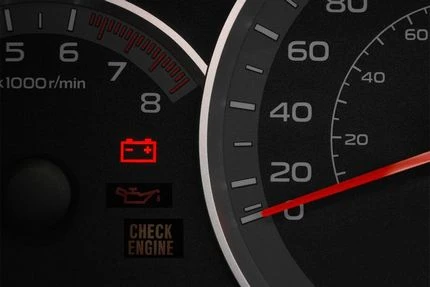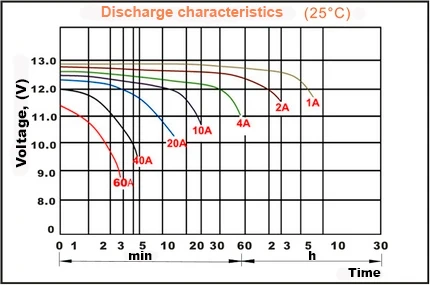Battery discharge time calculator

Battery discharge time calculator concerns many car owners. Especially if it has been found out in the morning that a driver has forgotten to turn off the light, and when trying to start the engine, it has turned out that the battery is run down. It that moment the following question arises: “could the interior lighting bulb or parking light run the battery down or is it a fault?”. Looking ahead, the answer is unambiguous — of course it could, especially if it is winter and the battery is not fully charged.
In order not to start the engine a day later, it is enough just to have a current leakage of 100 or more milliamperes, not mentioning a consumption source of 400-700 mA. You can check this by calculating the nominal time of the car battery discharge. The calculation formula is as follows:
T=Capacity (of the battery) / Consumer current
Our online calculator allows calculating the time during which the battery will operate when the source of current consumption is turned on, when you have accidentally forgotten to switch it off or have intentionally left to operate. The calculation is performed taking into account the rated capacity of the battery, the consumer power and the natural current leakage at solid state.
At low consumption current, a capacious battery can provide more operating time. Of course, the greater the battery capacity, the longer the operation time, but in this case the generator has to charge the battery longer. So, a short distance trip will not allow it to recover quickly. In winter, this can lead to the engine starter failure.
Battery discharge time

The way to calculate the battery discharge time can be understood by considering a specific case. For example, a 120-watt consumer is switched on in the car’s lighter socket. According to Ohm's law, you can calculate that it consumes 10 A of the battery per hour. That is, if there is a 55 Ah battery in the car, it will be fully discharged in 5.5 hours or less. But this is only an approximate calculation, as there are other factors that affect the current consumption. Note that in order for the car not to start, it is enough to have 15-25%, and this is about 4 hours.
Table of the battery discharge time with minimum consumption:
| Discharge percentage (%) | 10 | 20 | 30 | 40 | 50 | 60 | 70 | 80 | 90 | 100 |
| Discharge time (h)* | 7 | 14 | 20 | 26 | 32 | 39 | 45 | 52 | 58 | 64 |
*To calculate the discharge time, we have taken the minimum values of current leakage of 20 mA and the power of a car lamp of 10W from the battery with a capacity of 55Ah.
The data on 20 hours of the battery operation, which are indicated on its label, are factored in the current equal to 0.05 of its capacity.
Permissible battery discharge
The permissible discharge of the car battery is up to 30% of the start capacity (voltage is not lower than 11.8V). Note that you can start the engine only at the above-zero temperature at this level. In winter, do not allow even 50% of the discharge (12.1V).
How to use the battery discharge time calculator
With the elementary formula, you can calculate how long the battery will operate using a standard calculator, but you need to know the exact power consumption value and add the leakage value to it. Therefore, you can find out the battery discharge time much faster, depending on the load current, ticking the necessary consumers. To calculate the discharge time, you need to:
- Indicate the nominal value of the battery in the “Battery capacity” field.
- Specify both the average leakage — 25-35 mA, and the value checked with a multimeter in the “Current Leakage” field. To calculate a permissible value, use the online calculator, which displays the estimated normal leakage value at solid state depending on the type of consumers you have.
- Check (select from the list) the necessary consumers, which have caused the discharge (or there is a need to calculate the battery operating time). Lamp power is factored in the standard rating.
- In the “Consumer power” field, the value will change depending on the selected sources. Or you can enter a known value in watts or amperes.
- Click the «Calculate» button and you will get the result of the time in hours.
For reference, the power of a particular consumer is specified in the table below.
Table of the current consumers in a car
| Consumer | Power (W) | Required current (А) |
|---|---|---|
| Front parking lights | 5 x2 | 1-2 |
| High beam headlights/low beam headlights | 55 x2 | 7-10 |
| Anti-fog lights | 55 x2 | 7-10 |
| Rear anti-fog light | 21 x2 | 2–3,5 |
| Parking brake lights | 5 x2 | 1-2 |
| Rear parking lights | 5 x2 | 1-2 |
| License plate lighting | 2 | 0,17 |
| Brake light | 5 x2 | 1-2 |
| Audio system | 5-25 | 0,5-2 |
| Windscreen wipers | 60 | 5 |
| Defroster lines | 120 | 5-10 |
| Seat heaters | 85-160 | 7-14 |
| Heater fan | 80-200 | 6-16 |
| Autonomous heater | 60-120 | 5-10 |
| Ignition system | 20 | 2-4 |
| Engine control (ECU) | 10 | 1-2 |
FAQ
-
How long will a 60Ah battery last for a 60W discharge?
Taking into account that the 60Ah battery pack has been fully charged and the leakage current in the car mains is not more than normal, the battery will last no more than 12 hours when discharged by a 60 Watt consumer.
-
How long will a 7Ah 12v battery last?
To calculate the time for how long will be enough battery 7 Ah 12V, which can be used for alarms or lighting LED strip during a power outage at night, with a power consumption of 0.7 A will be enough for 10 hours of operation or 15 hours if the consumption of 5 watts.
-
What is the formula for battery discharge time?
The formula for the battery discharge time is: the capacity of the power supply (battery) expressed in A*h divided by the consumer current in amperes A. That is, t = Cp / In. However, this will only be an absolute value, the actual value is somewhat less. Because the battery can be considered dead when its voltage drops to 11.8 volts and the discharge is exponential.
-
What is the minimum battery discharge voltage?
The available capacity of a battery depends on the discharge mode and temperature, so the higher the load, but the lower the temperature, the minimum voltage to which the battery can be drained will be lower. On average, the minimum voltage of the discharged 12 volt battery in warm weather will be — 11.5V, and in winter the minimum voltage to which you can let the car battery is — 11.75V, which corresponds to 30 percent of its remaining capacity.
